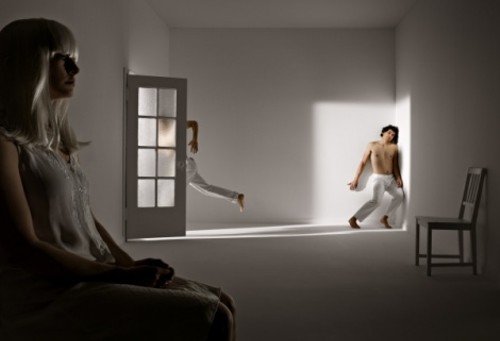For many people, contemporary dance is not very accessible. Choreographer Joe Goode knows why.
“Contemporary dance is up on a pedestal and removed from any kind of human conversational realm,” he says. “It’s considered high art, and alienates much of its audience.”
So Goode begins each performance by talking to his audience and assuring them they do not have to see this as “high art.” “We’re going to talk, sing and we’re going to do things that are recognizable to them,” he says. “We’re not only going to make extreme body positions and dance around in black tights.”
Goode says he finds that after conversing with his audience, they are more receptive to the hybrid dance-theater his group is known for. “Otherwise, people might waste too much time trying to get the work up on the pedestal.”
A Joe Goode performance is sure to be risqué, provocative and take some interesting turns. For example, in one piece, a dancer raises a plugged-in skill saw and starts the blade moving. He then dances, bounds and spins across the stage with the saw buzzing in his hands. The audience cringes with discomfort. The dancer saws a crooked line down the back of a wooden chair. Most audience members are stupefied with interest. The piece is called 29 Effeminate Gestures.
“I’m not a purist,” Goode says. “I want to connect with people. I’m willing to bring in lots of things [other than dance]; I’ll literally bring in the kitchen sink if it will help.”
Dance purists and theater purists sometimes scoff at Goode’s approach of mixing performance-art genres. “The dance world said, ‘You’re not really a dancer because you’re talking,’” Goode says. “And the theater world said, ‘You’re not really a theater artist or a playwright because you’re dancing.’”
Despite the critical disapproval, Goode’s performances are wildly popular in the dance and theater worlds. When asked why he chose to mix these forms, he responds, “I think the question is more, ‘Why did somebody decide to un-mix them?’ They belong together.
“The human body holds emotion, holds experience,” Goode continues. “The voice is part of the human body. Why did we de-voice dancers?”
Goode doesn’t pay a lot of attention to this debate, however. According to him, art is art. Breaking it up into categories is just silly. He is more interested in producing a moving and authentic experience for the audience.
“The audience is perceptive,” Goode says. “They can tell when it’s something that’s trying to impress them with its colossal greatness, and they can tell when something really happens.” The trick is to make the audience believe that what is happening onstage is real—real pain, real pleasure, real fear.
Goode does this through “felt performance.” It is a technique he has developed over his 20 years directing the company. “A performance should feel like somebody up there is having a real experience,” Goode says. “That is when performance is good.” In order to do that, a performer must really feel what he or she is doing.
To discover felt performance, Goode’s performers begin with a theme or scenario—for example, two people falling into each other’s arms. The dancers will fall tenderly, roughly, hurriedly and so on until it feels right. “We’re going to really explore every possible way we can fall into each other’s arms,” Goode says. “The ones that performers can really own are the ones we’re going to use.” Those are felt performances.
Onstage, the performer doesn’t have to act. He or she is truly feeling the sentiment. “They’re not just showing me,” Goode says, “they’re actually living it in the moment.”
Because of so much reliance on felt performance, Goode’s performers’ personal experiences and talents determine how a piece is written and choreographed. If it isn’t personal, it cannot be felt.
Goode—the principal choreographer and writer—acts as more of an artistic director. The group’s pieces are collaborative from their inception to performance. “The dancers are really in control of the process,” Goode says. “I just have the subject matter, and we start workshopping and see what we come up with.”
Goode doesn’t tell his dancers what to do, but he challenges them with problems to solve and themes to explore. “We don’t know what the pieces will look like until they finish themselves,” Goode says.
For example, The Rambler, which will be performed at Kingsbury Hall on Feb. 25, began as an exploration of an American myth. The Rambler is the Clint Eastwood or Jack Kerouac character who sets off on his own, defies tradition and custom, and seeks independence and adventure. With that as a starting point, the company produced many offshoots of the theme ranging from the Buddha to cop dramas.
“It kind of defines the American spirit,” Goode says.
Like most of Goode’s work, The Rambler will likely go to unexpected places, far away from the confines of traditional dance.
JOE GOODE PERFORMANCE GROUP: THE RAMBLER
Kingsbury Hall
1395 E. Presidents Circle, University of Utah
801-581-7100
Saturday, Feb. 25, 7:30 p.m.
$19.50-$29.50
KingsburyHall.org
More by Jeremy Asay
-
Corporate Rock
SLC barbershop redecorates after lawsuit
- Nov 9, 2011
-
Ty Segall
Prolific SF songsmith 'rawks' it
- Oct 4, 2011
-
Keller Williams
He jams, but he's not a jam band
- Sep 15, 2011
- More »



